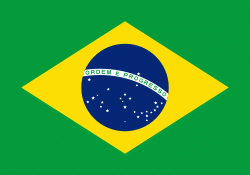Cuiabá
 |
 |
Cuiaba is the heart of an urban area that also includes the state's second largest city, Várzea Grande. Thermal electric and hydroelectric plants located in the area have been expanded since the completion of a natural gas pipeline from Bolivia in 2000 (see Pantanal Pipeline by Alex Ramsay). The city is the seat of the Federal University of Mato Grosso and the largest football stadium of the state, Arena Pantanal.
The city is a rich mix of European, African and Native American influences and numerous museums reflect this. Cuiabá is also notable for its cuisine, dance, music and craftwork. Known as the "Southern gate to the Amazon", Cuiabá experiences a hot humid tropical climate.
Cuiabá was founded on January 1, 1727, by Rodrigo César de Menezes, then the "captain" of the captaincy of São Paulo in the aftermath of the discovery of gold mines. The Rosário Church built at the time in the centre of the little town marked the location of a rich seam of gold. However, in 1746 much of the town was destroyed by an earthquake.
It was given township status in 1818 and became the state capital in 1835.
From the late eighteenth century, until the time of the Paraguayan War (1864-1870), the town remained small and was in decline. The war, however, brought some infrastructure and a brief period of economic boom, with Cuiabá supplying sugar, foodstuffs, and timber to the Brazilian troops.
After the war, the town was once again forgotten by the rest of the country, to such an extent that the Imperial and later the Republican governments of Brazil used to use it as a site of exile for troublesome politicians. Isolation allowed it to preserve many of the oldest Brazilian ways of life until well into the twentieth century.
Starting in 1930, the isolation was diminished, with the construction of roads and later with the advent of aviation. The town became a city and would grow quite rapidly from 1960 onwards, after the establishment of the newly built Brazilian capital in Brasília.
In the 1970s and 1980s, the pace of growth would continue to increase as agriculture became commercialized, using the roads to transport soybeans and rice produced in the state in order to be sold abroad. The growth was such that from 1960 to 1980 the small town of 50,000 inhabitants grew into a giant, with more than a quarter of a million inhabitants (including those from the surrounding area and towns).
Since 1990, the rate of population growth has decreased, as other towns in the state have begun to attract more immigration than the capital. Tourism has emerged as a source of income and environmental issues have become a concern for the first time.
Map - Cuiabá
Map
Country - Brazil
Currency / Language
| ISO | Currency | Symbol | Significant figures |
|---|---|---|---|
| BRL | Brazilian real | R$ | 2 |
| ISO | Language |
|---|---|
| EN | English language |
| FR | French language |
| PT | Portuguese language |
| ES | Spanish language |


















